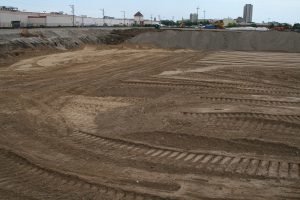By JANE MCCLURE
Tax increment financing (TIF) proceeds will be used to fill a $900,000 gap in environmental cleanup funding needs for the Major League Soccer stadium under construction at Snelling and University avenues. On July 19 the St. Paul City Council voted 5-2 to support the use of TIF to help pay for the cleanup of the former Metro Transit bus garage site.
 Use of TIF was opposed by council members Rebecca Noecker and Jane Prince, as well as speakers including Hamline-Midway resident and mayoral candidate Tom Goldstein, noting that final agreements with Midway Center developer and center owner RK Midway aren’t complete, “We’re pursuing a project that is a leap of faith. We seem to be pulling out every stop for this.” Goldstein disputed claims that the stadium will provide economic revitalization for the area.
Use of TIF was opposed by council members Rebecca Noecker and Jane Prince, as well as speakers including Hamline-Midway resident and mayoral candidate Tom Goldstein, noting that final agreements with Midway Center developer and center owner RK Midway aren’t complete, “We’re pursuing a project that is a leap of faith. We seem to be pulling out every stop for this.” Goldstein disputed claims that the stadium will provide economic revitalization for the area.
Work at the site is well underway. The $10 million building permit issued July 14 is for excavation, site work and footings only. Much of the property has been excavated, leaving a large hole.
The financial hole stems from a plan the City Council approved more than a year ago, for $18.4 million for infrastructure and site cleanup. The St. Paul Port Authority is leading site cleanup efforts. Last year Port officials said they’d seek $1.5 million in grant funds to help with pollution cleanup. Grants have been elusive. The bus barn property, which is owned by Metropolitan Council, isn’t eligible for the council’s own cleanup grants.
Of $3.1 million in project grants, the Port has obtained only $325,000 to be used on the bus barn property. A shortfall of $825,00 to $1.18 million is anticipated. A Ramsey County grant is pending. Most council members agreed that not being able to use Metropolitan Council cleanup funds on a polluted site the council owns is an odd situation.
Jonathan Sage-Martinson, director of the St. Paul Department of Planning and Economic Development (PED), outlined the situation of cleanup costs and grant complexities. He said the city and Port Authority wanted to use pollution cleanup-specific grants, but TIF would be a second potential funding source. That was always the city’s intent, he said.
Metropolitan Council has pledged up to $4.5 million to help redevelop the old bus barn site for redevelopment. But that isn’t through traditional redevelopment or cleanup grants the Council gives. In an email to city officials, Metropolitan Council stated that the grants for tax base revitalization are supposed to bring about property tax-generating redevelopment, and not be used for tax-exempt property. The stadium, which is being built by Minnesota United FC at the cost of $150 million, will eventually be owned by the city with the city leasing the former bus barn site from Met Council. Noecker called the situation “mind-boggling.”
It’s estimated that cleaning up the entire stadium property, on both public and private land, will cost more than $7 million.
Prince and other council members also criticized the Metropolitan Council for not letting the city use its grants for cleanup since transit operations resulted in some of the site pollution. “This is the Metropolitan Council’s site that the Metropolitan Council has been polluting,” said Prince.
“It’s a zero-sum game,” said Noecker.
The TIF funding, which the St. Paul Port Authority Board recommend for approval in June, takes tax increment proceeds from two other sites and uses them at Snelling and St. Anthony avenues.
Port Authority and City Council actions amended the Midway Industrial Development District, which is now named Snelling-Midway. The amendments then take revenue from two other industrial development districts, Maxson Steel on Dale St. near Como-Dale-Front, and the Energy Park Development District. TIF will be used from Maxson Steel’s sub-district Great Northern Business Center Phase II and Energy Park’s sub-district Energy Lane Business Center. These two sub-districts currently have TIF receipts greater than the amount of money needed to pay their current costs. With the changes now in place, the money is available to be used at Snelling-Midway. The changes free up $375,000 from Energy Lane and $500,000 from Great Northern to use at the stadium location.
Sage-Martinson asked the City council to look at the “opportunity costs” of use TIF to help pay for cleanup and the stadium project. The stadium is seen as a catalyst for redevelopment of the superblock bounded by St. Anthony, Snelling and University avenues and Pascal St.
“This is a high priority site to clean up,” Sage-Martinson said.
Comments
No comments on this item Please log in to comment by clicking here